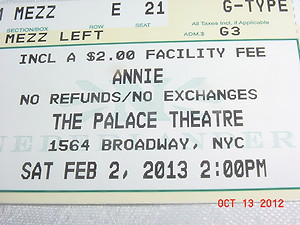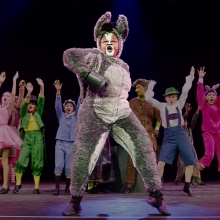Brisa's Pieces: Broadway Box Office Reports Made Easy
Brisa's Pieces: Broadway Box Office Reports Made Easy
By Brisa Trinchero on January 17, 2013
 Every Monday, my friends at The Broadway League publish the weekly Broadway grosses. This means that industry insiders and savvy fans can get a sense of how each Broadway show has fared at the box office. These gross reports provide valuable information about which shows are going strong and which ones you should see quickly before they depart from the Great White (expensive!) Way.
Every Monday, my friends at The Broadway League publish the weekly Broadway grosses. This means that industry insiders and savvy fans can get a sense of how each Broadway show has fared at the box office. These gross reports provide valuable information about which shows are going strong and which ones you should see quickly before they depart from the Great White (expensive!) Way.However, since reading the gross reports can feel a bit like interpreting a foreign language to those who don’t speak finance, I thought I’d take a moment to walk you through the numbers.
Here’s a recent report of each show’s gross profits. Take a minute to click the link, so you can follow along with me below.
First all, you need to understand the term: Gross Profits. It basically means the total of all monies that have come in through ticket sales in a given week. Producers report this information to The Broadway League, who in turn compile the report. This alone, won’t mean much though, unless you also understand the expenses that then come out of that big number.
Let’s use the current revival of ANNIE as an example. Big musicals cost anywhere from $400,000 to north of $800,000 per week to stay open. Those costs include things like:
Theater rental
Cast and crew salaries
Marketing
Creative royalties
And more . . .
To make our math easy, let’s pretend it costs $500,000 a week to run ANNIE on Broadway. That means that if last week’s grosses were $839,273, then simple arithmetic will show us that:
$839,273 – $500,000 = $339,273 (or the net profits)
So what happens with these profits? That’s when investors and producers start getting checks in the mail! You’ll often hear the term “recouping.” This means a show has had net profits for enough weeks in a row (generally a year or more) that the left over money has been paid back (recouped the investment made by).
 If that net profit number is negative too many weeks in a row, it means a show can’t cover its running costs from ticket sales that week and is surviving on its reserve funds. Producers have to think fast about creative ways to get the grosses up (i.e. sell more tickets) or they’ll be forced to close the show.
If that net profit number is negative too many weeks in a row, it means a show can’t cover its running costs from ticket sales that week and is surviving on its reserve funds. Producers have to think fast about creative ways to get the grosses up (i.e. sell more tickets) or they’ll be forced to close the show.There are lots of shows poised to open in the coming months. If you want to play “producer,” make some guesses on costs based on what we’ve talked about. You should use a lower number than $500K for smaller musicals, a bigger number for musicals with big casts or Hollywood stars. Then watch the numbers. Over time you, too, will be able to guess if it’s curtains or ka-ching!

Read all of Brisa's Pieces here.
You can reach Brisa via MTIShowspace or on twitter: @brisatrinchero. I also blog about the art and business of new musicals at www.makemusicals.com. I look forward to hearing from you!
























